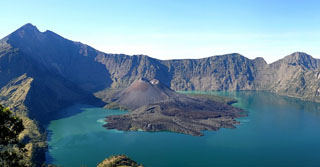Report on Rinjani (Indonesia) — October 1994
Bulletin of the Global Volcanism Network, vol. 19, no. 10 (October 1994)
Managing Editor: Richard Wunderman.
Rinjani (Indonesia) Ash eruptions continue; cold lahar kills 30 people
Please cite this report as:
Global Volcanism Program, 1994. Report on Rinjani (Indonesia) (Wunderman, R., ed.). Bulletin of the Global Volcanism Network, 19:10. Smithsonian Institution. https://doi.org/10.5479/si.GVP.BGVN199410-264030
Rinjani
Indonesia
8.42°S, 116.47°E; summit elev. 3726 m
All times are local (unless otherwise noted)
An eruption in June (19:05) sent ash plumes 2,000 m above the summit, resulting in ashfall on nearby villages. Activity of some kind was apparently continuing in late October. A NOTAM from the Bali FIR reported a volcanic ash cloud up to 900 m above the summit, with an average of one eruption per day.
On 3 November, a cold lahar from the summit area traveled down the Kokok Jenggak River. Thirty people from the village of Aikmel who were collecting water from the river were killed; one person remained missing as of 9 November. No damage to the village was reported. Local volcanologists noted that additional lahars could be triggered by heavy rainfall.
Geological Summary. Rinjani volcano on the island of Lombok rises to 3726 m, second in height among Indonesian volcanoes only to Sumatra's Kerinci volcano. Rinjani has a steep-sided conical profile when viewed from the east, but the west side of the compound volcano is truncated by the 6 x 8.5 km, oval-shaped Segara Anak (Samalas) caldera. The caldera formed during one of the largest Holocene eruptions globally in 1257 CE, which truncated Samalas stratovolcano. The western half of the caldera contains a 230-m-deep lake whose crescentic form results from growth of the post-caldera cone Barujari at the east end of the caldera. Historical eruptions dating back to 1847 have been restricted to Barujari cone and consist of moderate explosive activity and occasional lava flows that have entered Segara Anak lake.
Information Contacts: UNDHA; BOM Darwin, Australia.

